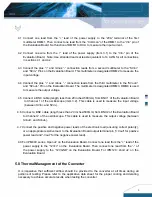
Test (Turn on the module by using the external switch)
1) Turn on the fan.
2) Turn on the input power supply and set it to the desired operating point.
3) Set channel 1 on the oscilloscope to be DC coupled and to the appropriate range for the
input voltage.
4) Connect a coaxial cable from channel 1 to BNC1 on the Evaluation Board.
5) Set channel 2 on the oscilloscope to be DC coupled and to the appropriate range for the
output voltage.
6) Connect a coaxial cable from channel 2 to BNC2 on the Evaluation Board.
7) Set the Time base to 5mS/Div
8) Set the Trigger mode to normal trigger and set the Trigger level at approximately 2V (rising)
or suitable trigger point (referring to data sheet) on channel 2.
9) Turn on the external switch to supply power source to module and use the cursor V Bars of
Scope to measure the delay time, and then record the waveform on the oscilloscope.
Test (Turn on the module by using the Enable on/off)
1) Turn on the fan.
2) Turn on the input power supply and set it to the desired operating point.
3) Set channel 1 on the oscilloscope to be DC coupled and to 1V/division. (Refer to data
sheet).
4) Connect a scope probe from channel 1 between the on/off control pin and reference
ground (SGND) on the Evaluation Board.
5) Set channel 2 on the oscilloscope to be DC coupled and to the appropriate range for the
output voltage.
6) Connect a coaxial cable from channel 2 to BNC2 on the Evaluation Board.
7) Set the Time base to 5mS/Div
8) Set the Trigger mode to normal trigger and set the Trigger level at approximately 2V (rising)
or suitable trigger point (referring to data sheet) on channel 2.
9) Turn on-off Enable switch (SW1) and use the cursor V Bars of Scope to measure the delay
time, and then record the waveform on the oscilloscope.
8.4. Thermal Characteristic
8.4.1 Efficiency
Efficiency is the ratio of total output power to the input power. It is typically measured at full
load and nominal input voltage.
Test
1) Turn on the fan.
2) Set the enable switch SW1 to the “OFF” position to enable the converter.
3) Adjust the input voltage to the desired operating point.
4) Set the electronic or resistive Load to the desired operating point.
5) Read and note the output voltage (DMM3) and input voltage (DMM2).
6) Read and note the input and output currents from the DMM1 and the electronic load.
12

































